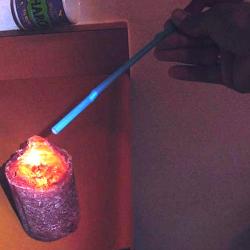Source Institutions
Add to list Go to activity
Activity link broken? See if it's at the internet archive

In this demonstration, learners observe vinegar and baking soda reacting to form carbon dioxide (CO2) gas. The CO2 gas is trapped in a balloon, then blown through a straw into water with an acid-base indicator. The indicator changes to indicate that CO2 mixed with water becomes an acid. This demonstration is part of a set of demonstrations and activities that can be used together for a larger lesson. Resource contains vocabulary definitions and suggestions for assessment, extensions, and scaling for different levels of learners.
- 5 to 10 minutes
- 5 to 10 minutes
- 1 cent - $1 per group of students
- Ages 8 - 14
- Activity, Demonstration
- English
Quick Guide
Materials List (per group of students)
- A narrow-neck bottle (such as a beer bottle)
- 50 ml vinegar
- 45 grams baking soda
- 1 small, round balloon
- 1 straw
- 50 ml bromothymol blue (BTB) solution (6 drops per 1/3 cup of water)
- 1 clear beaker (large enough to hold 50 ml of BTB solution)
- Hot Stuff! Activity 1 Worksheets
Subjects
-
Earth and Space Science
-
Earth Processes
- Weather and Climate
-
Earth Structure
- Atmosphere
-
Earth Processes
-
Engineering and Technology
-
Engineering
- Civil Engineering
- Environmental Engineering
-
Engineering
-
Life Sciences
-
Ecology
- Human Impact
-
Ecology
-
Physical Sciences
-
Chemistry
- Chemical Reactions
- Acids and Bases
- Solutions
-
States of Matter
- Gases
-
Chemistry
Audience
To use this activity, learners need to:
- see
- see color
Other
Includes alignment to state and/or national standards:
This resource is part of:
Access Rights:
- Free access
By:
- Kolenbrander, Amy ; Yowell, Janet ; Mach, Natalie ; Schaefer Zarske, Malinda ; Carlson, Denise ; Kotys-Schwartz, Daria
Source Collection
- TeachEngineering
Rights:
- All rights reserved, Regents of the University of Colorado, 2004
Funding Sources:
- Fund for the Improvement of Postsecondary Education (FIPSE)
- U.S. Department of Education
- National Science Foundation, 0226322
